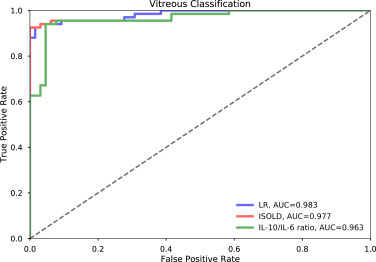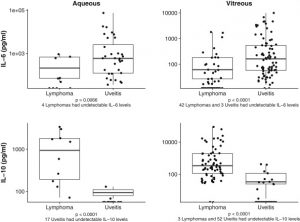In this study published in the journal Ophthalmology, the authors evaluated the use of a logistic regression model for early diagnosis of primary vitreoretinal lymphoma. Primary vitreoretinal lymphoma is a rare disease with a generally poor prognosis. Early diagnosis of local ocular disease has been shown to prolong survival significantly, but because the disease is rare and the ocular symptoms are nonspecific, it is often misdiagnosed. In addition, although cytologic analysis of aqueous or vitreous samples is diagnostic, there are often problems with lymphoma cell detection in the sample. As a result, the diagnosis of PVRL is often delayed, taking on average 1 to 2 years from the onset of symptoms and typically requiring multiple biopsies.

Various other diagnostic approaches have therefore been developed, including intraocular cytokine analysis in which the IL-10-to-IL-6 ratio is used to differentiate lymphoma from uveitis, but results have been mixed. However a recent study showed that a logistic regression model, the Interleukin Score for Intraocular Lymphoma Diagnosis, was able to accurately estimate the probability of PVRL based on IL-6 and IL-10 levels in a large multicenter European cohort.
In this study, the authors evaluated the generalizability of this approach compared to the IL-10 to IL-6 ratio in a single-center retrospective American cohort. They also trained and tested a logistic regression model to assess the overall diagnostic performance of logistic regression for differentiating PVRL from uveitis in the same cohort. They found that the ISOLD score generalized very well to the US patient cohort, classifying PVRL versus uveitis from vitreous data with high sensitivity and specificity and correctly classified all patients in the aqueous data set. Both the logistic regression model that the authors developed (98.3%) and ISOLD score (97.7%) performed better than the IL-10-to-IL-6 ratio (96.3%) when compared using area under the curve, but clinically the three classifiers performed very similarly at their optimal cutoffs.
The authors conclude that logistic regression provides two additional benefits, however, when compared to the IL-10-to-IL-6 ratio. First, logistic regression provides a more nuanced and informative estimated probability of primary vitreoretinal lymphoma (by considering both the individual cytokine levels in addition to the ration between them). Second. the models have the potential to improve and become more accurate given additional data, while the ratio method remains a fixed approach.
The results of this study are exciting as they show that the logistic regression approach is generalizable and has potential for further refinement with better data. Although further validation is needed, these findings suggest that intraocular cytokine analysis by logistic regression may be a promising adjunctive test to cytopathologic analysis, the current gold standard for the diagnosis of primary vitreoretinal lymphoma.
Kuo DE, Wei MM, Knickelbein JE, Armbrust KR, Yeung IYL, Lee AY, Chan CC, Sen HN. Logistic Regression Classification of Primary Vitreoretinal Lymphoma versus Uveitis by Interleukin 6 and Interleukin 10 Levels. Ophthalmology. 2020 Feb 5. Feb 5. pii: S0161-6420(20)30085-3. doi: 10.1016/j.ophtha.2020.01.042. [Epub ahead of print]

